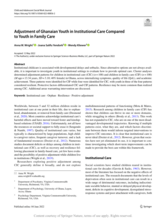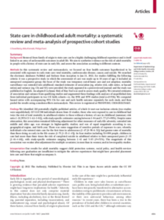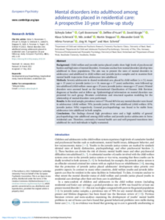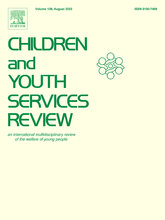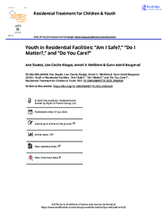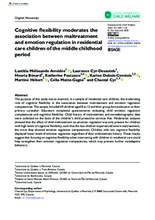Displaying 121 - 130 of 767
Institutional childcare is associated with developmental delays and setbacks. Since alternative options are not always available, it is important to investigate youth in institutional settings to evaluate how to provide optimal care.
Removal from family of origin to state care can be a highly challenging childhood experience and is itself linked to an array of unfavourable outcomes in adult life. This systematic review which included Canada, the US, western Europe, and Australia, aimed to synthetise evidence on the risk of adult mortality in people with a history of state care in early life, and assess the association according to different contexts.
Child welfare and juvenile justice placed youths show high levels of psychosocial burden and high rates of mental disorders. It remains unclear how mental disorders develop into adulthood in these populations. The aim of this study, based on adolescents in Swiss residential care, was to present the rates of mental disorders in adolescence and adulthood in child welfare and juvenile justice samples and to examine their mental health trajectories from adolescence into adulthood.
This paper presents a case study that discusses the lived experiences of two LGBTQA + young people who have been in out-of-home care in Australia, focusing particularly on the influence of relationships on their developing sexual identity.
Several youth facilities have devoted considerable resources to improving the quality of practice and the interest in understanding the safety needs of youth in residential care has grown. However, there is limited research that considers how youth in residential facilities themselves define and experience safety, what their safety concerns are, and how they would like systems and staff to respond to their needs. Therefore, this current study investigated youth perceptions of safety in residential facilities in Norway and their experiences of and reaction to staff behaviors and attitudes.
Previous studies have shown that mental health disorders (MHD) among parents might be an important mechanism in the intergenerational transmission of out-of-home care (OHC). The current study aimed to further study this interplay by investigating the associations between OHC and MHD within and across generations in a Swedish cohort.
This article presents Kaupapa Māori research undertaken by a mokopuna Māori with the lived experience of state care in New Zealand, alongside established Kaupapa Māori researchers. Literature containing the voices of care-experienced mokopuna Māori was reviewed to explore what conditions exist and are needed to uphold wellbeing.
The purpose of this study was to examine, in a sample of residential care children, the moderating role of cognitive flexibility in the association between maltreatment and emotion regulation competencies. The sample included 69 children aged 8 to 12 and their group home educator as their primary caretaker. Educators completed questionnaires evaluating child emotion regulation competencies and cognitive flexibility.
This study provides an overview of the family reunification process of Latinx adolescents who have migrated to join their families in the United States.
This briefing paper draws on data and findings from the Insights into the World of Privatized Faith-Based Residential Care Facilities in Myanmar research report.

